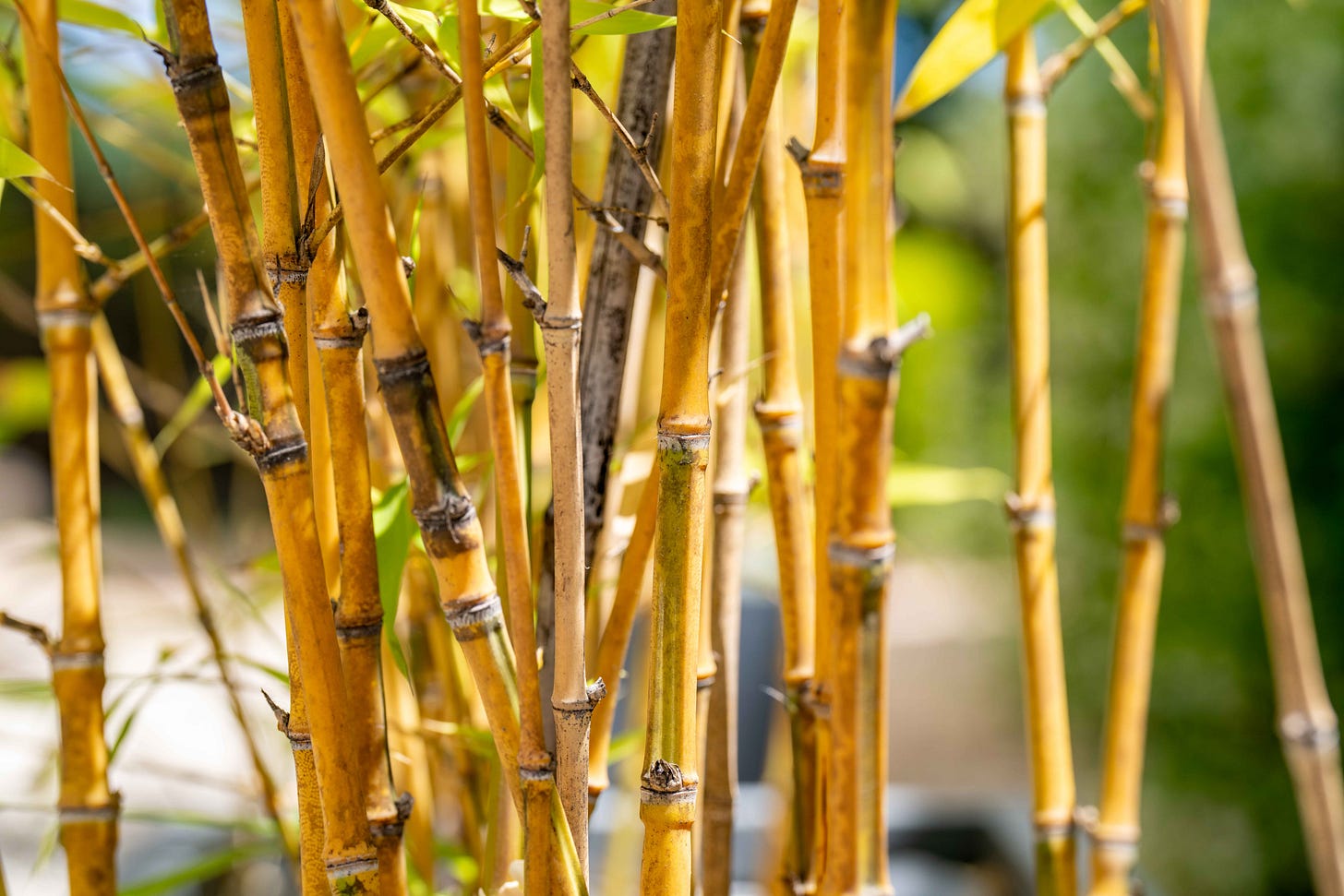Eradicate Invasives in Your Garden
By Penny Pawl
NAPA VALLEY, Calif. — When my husband and I first started gardening at our new Napa home, we made many errors. One big mistake was planting invasive plants.
We really wanted bamboo, but we knew it had a reputation for taking over gardens. My husband put golden bamboo (Phyllostachys aurea) in half a wine barrel set on concrete blocks. A year or so later we noticed something coming out of the bottom, creeping across the soil and headed to a garden bed. We never imagined that bamboo had a mind of its own. Bye-bye bamboo.
My neighbors planted giant bamboo (Dendrocalamus giganteus) next to their front porch. It put on a beautiful show when it bloomed, but then the roots started creeping under the house. After fighting the bamboo for a while, they removed it permanently.
A retired Master Gardener who has since moved away had a wonderful old house on Coombsville Road. On one side of her home was a magnificent old wisteria. This vine sent roots and shoots under her cement basement, and they emerged on the other side.
Wisteria planted in the wrong place can indeed be invasive. I transplanted it from our first house in Napa to our next home in Calistoga, then back to Napa. I still have it in my current garden, but I planted it on a fence far from structures. And I check it often for sprouts moving in every direction. Heavy pruning also helps keep this plant in check.
My husband and I planted pampas grass (Cortaderia selloana) when we first started landscaping. Those huge plants try to take over the world. It was slowly moving toward the road, so I had it removed.
Everyone loves redwood trees. They’re practically a symbol of Northern California.
But they should never be planted near a home or in a home landscape. I have been digging in a raised bed in preparation for planting my summer garden, and guess what I found: tons of redwood feeder roots. In fact, I found one fat root that is no longer a feeder. I plan to have a helper dig up this bed. Then I will solarize the soil next summer to kill the remaining feeder roots. This means wetting the soil, then covering it with black plastic sheeting and letting it bake in the summer sun. The heat will also kill most weed seeds. As I weed, I am finding baby redwoods everywhere. The winter rains encouraged the seeds to sprout, and squirrels have fun throwing the seed pods everywhere.
My husband wanted trees that grew fast, so he planted a Monterey pine (Pinus radiata) near our house. They are known to grow more than 6 feet a year and to get just as big around as they are tall. Within a few years this tree was indeed very big. Then one summer it split, and part of the tree was pointed toward the house. In a delicate operation, my husband and a neighbor used a pickup truck and rope to take it down. We never planted another Monterey pine.
I have also been grappling with nandina (Nandina domestica). Some varieties send out long roots that eventually decide to grow a new plant. Unless you want a nandina forest, be sure to buy the clumping type for your garden. Mine had to be dug out.
There are about 40 plants considered extremely invasive in California. Some nurseries still carry these plants, so do a little research before you buy. Most of these bad boys have beautiful flowers and do well in our soils and climates.
Scotch broom (Cytisus scoparius) is a good example. This plant spreads over large areas, pushing out native plants. We once traveled a back road at Point Reyes and saw nothing for miles except blooming Scotch broom. Native plants and wildlife evolve together, so a thuggish plant like Scotch broom can create a wildlife desert.
Some honeysuckle (Lonicera japonica) is also invasive. I have two that I propagated from cuttings. While they are in large pots and growing well, I am aware that they may have broken through the pots and rooted in the soil. They are huge, and I have not tried to move them. They are growing on a screen that provides a visual barrier in my back garden, and the bumblebees love them. I am just happy that I did not plant them in the soil.
I have also unwittingly acquired a stand of Himalayan blackberries (Rubus armeniacus). I suspect that birds planted them. These vines are invasive and will need to be taken out this summer. They are thorny, so it will be a major project.
Before you bring any new plant home from a nursery, do yourself a favor and make sure it is not on California’s invasive plant list. You can find this information easily online.
Library Talk: Join UC Master Gardeners and Napa County Library for “All About Lavender,” on Thursday, June 6, from 7 to 8 p.m., via Zoom. Have you ever wondered what you can do with that gorgeous lavender growing in your backyard? Learn what lavender needs to thrive and harvest ideas for how to incorporate it in your own homemade creations. Register to receive the Zoom link.
Workshop: Join UC Master Gardeners of Napa County for a workshop on “Planting for Monarchs and Other Pollinators” on Sunday, June 16, from 2 to 4 p.m., at Yountville Community Center, 6516 Washington St., Yountville. Learn about host plants and nectar plants and how to include them in your garden. This workshop is offered in partnership with Yountville Parks and Recreation Department. Register on their website. Click Adult Activities, then UC Master Gardeners, then Planting for Monarchs and Other Pollinators.
Help Desk: The Master Gardener Help Desk is available to answer your garden questions on Mondays and Fridays from 10 a.m. until 1 p.m. at the University of California Cooperative Extension Office, 1710 Soscol Ave., Suite 4, Napa. Or send your questions to mastergardeners@countyofnapa.org. Include your name, address, phone number and a brief description. For best results attach a photo.
If today's story captured your interest, explore these related articles:
Penny Pawl is a UC Master Gardener of Napa County.





Wonderfully fun and informative report! I inherited several invasives planted by innocent former owners...and was sad to have to remove several Monterey pines after they started turning bright orange. According to my arborist, trying to console me, they have a limited life span. I am still nurturing a displaced redwood on my hillside which needs deep irrigation in hot weather. But my favorite take-over, "rule the world" plant is vinca, which after a half century of frequent neglect in my yard is still the aggressive spreader! On another topic, could you or one of the other master gardeners provide hints about "deer-proof" plants you have experience with?
Excellent article Penny! As a new Master Gardener, this is great information for me. Thanks!